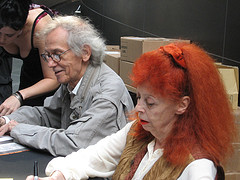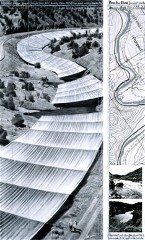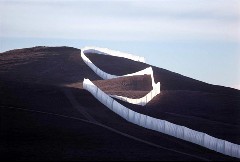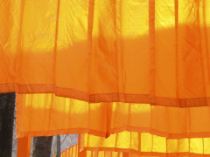
Christo and Jeanne-Claude sign books after speaking at the Kimmel Center’s Perelman Auditorium
Big thinkers and big-time sculptors Christo and Jeanne-Claude came to town Monday to speak at the Global Creative Economy Convergence Summit. (I swear that was the name of the conference–take a teaspoon of New Age and mix with a teaspoon of business promotion and toss with some international blah-blah and voila)! Natch, Roberta and I went to hear the artists, even though we had heard them address the Fairmount Park Art Association several years ago.
The Q & A following the talk was outstanding. But first Christo recounted how difficult it can be for them to get municipalities and other governmental bodies to OK the art projects–more than 20 years in some cases. They are currently negotiating for a project called Over the River, a long, semi-sheer canopy of fabric over a 7 miles stretch of the Arkansas River in Colorado. River rafters during the 2-week period of the installation would look up and see the fabric, with some trees and clouds visible through the cloth.

Over The River, Project For Arkansas River, Colorado, drawing by Christo, 1998. In two parts: 244 x 106,6 cm and 244 x 38 cm
(96×42” and 96×15”), pencil, charcoal, pastel, wax crayon, photographs by
Wolfgang Volz and topographic map. Photo: Wolfgang Volz, ©Christo 1998
Jeanne-Claude occasionally relieved the concentration required to understand Christo’s Bulgarian accent by chiming in–her main point being that people keep referring to them as the wrapping artists, when in fact they haven’t created a wrapped piece in years. It occurred to me that most businesses would regard the heavily imprinted branding–the wrapping artists–as a plus, not a minus, but there you go. She later noted that most artists are mentioned by their name–for example an exhibit of Picassos–but their work is known by the name of each piece.

Running Fence, Sonoma and Marin Counties, California 1972-76, by Christo and Jeanne-Claude, Photo: Wolfgang Volz, ©1976 Christo
The talk was peppered with interesting facts–the Gates cost $21 million. The artists include local engineers in their design teams (a way to grease the skids). They use other people’s property whenever they create a project, so they are in effect renting the land for the duration of the project.
The couple met in Paris in 1958. Jeanne-Claude was a spoiled brat, whose mother hired Christo to paint a portrait (the mother’s portrait, that is). He ended up painting three portraits and by then love had bloomed. They were both born June 13, 1935 at the same hour. They moved to New York in 1964. Their son, Cyril, is 40 years old and is a father himself.

The Gates, by Christo and Jeanne-Claude, catch the winter light and breeze in a photo by Cate Fallon
During the Q&A, Christo described their projects as pneumatic and temporary, the fabric always moving in the air currents. “We borrow that space and create a gentle disturbance for a few days.” Usually it’s 14 days. The Gates were 16 days to allow an extra weekend, at the request of New York City.
The couple bought 5,000 tons of steel (from Pennsylvania) for The Gates, a quantity equal to 2/3 of the steel of the Eiffel Tower. “We were very lucky,” said Jeanne-Claude. “We bought it in Pennsylvania when nobody wanted steel. …By the time the recycler came and bought our steel, suddenly China wanted steel, and the recycler gave us a big check. We couldn’t believe it.”
The success of the Gates is part of what’s slowing down Over the River. “Colorado does not like visitors,” Christo said.
Because each work of art they make has different technical requirements, “Each project for us is an absolute university,” said Jeanne-Claude.
Until now, they have created 19 projects. “But we have 41 failures,” said Jeanne-Claude. A failure is a project that either was ultimately rejected, or a project that, by time it was accepted, the couple had lost interest. By time permission to wrap a Christopher Columbus statue in Barcelona came through, Jeanne-Claude said it felt like a 40-year-old who finally got the little red bicycle they longed for as a child. The project never happened.
She said Christo knew he wanted be an artist when he was six years old, but Jeanne-Claude became an artist “out of love for Christo.” They do everything together, except Christo alone puts the ideas on paper; the two don’t fly together; and Jeanne-Claude alone works with the accountant.
When the couple met, said Jeanne-Claude, Christo was a young Bulgarian refugee. He washed cars and dishes and painted portraits for rich ladies. The portraits were the best source of income. His art work–now drawings of the projects–are still their best source of money. They have no sponsors. They trademark and copyright the image.
Once a project is up and they are no longer doing the creative part, it’s all about logistics, said Jeanne-Claude. But when that project goes up, “It is always a million times more beautiful than our wildest dreams.”
Afterward, they signed books.









